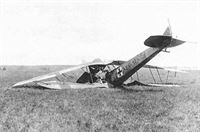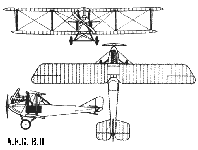
Описание
Страна: Германия
Год: 1915
Reconnaissance
Варианты
- AEG - B.I / Z6 - 1914 - Германия
- AEG - S1 - 1914 - Германия
- AEG - B.II / B.III - 1915 - Германия
- O.Thetford, P.Gray German Aircraft of the First World War (Putnam)
- J.Herris AEG Aircraft of WWI (A Centennial Perspective on Great War Airplanes 16)
- M.Dusing German Aviation Industry in WWI. Volume 1 (A Centennial Perspective on Great War Airplanes 84)
-
J.Herris - AEG Aircraft of WWI /Centennial Perspective/ (16)
AEG B.II B.260/14
-
J.Herris - AEG Aircraft of WWI /Centennial Perspective/ (16)
B.II AEG 191 from the AEG Flugplatz Nieder-Neuendorf
-
M.Dusing - German Aviation Industry in WWI. Volume 1 /Centennial Perspective/ (84)
AEG B.II (Z9) B.260/14 with Daimler (1915) ready for flight.
-
J.Herris - AEG Aircraft of WWI /Centennial Perspective/ (16)
Front view of an AEG B.II. (The Peter M. Bowers Collection/The Museum of Flight)
-
J.Herris - AEG Aircraft of WWI /Centennial Perspective/ (16)
This view of AEG B.II B.283 shows the overall shape and many national insignia on the wings, but none on the fuselage. (The Peter M. Bowers Collection/The Museum of Flight)
-
J.Herris - AEG Aircraft of WWI /Centennial Perspective/ (16)
AEG B-type trainers at AEG Flugplatz Nieder-Neuendorf. These aircraft were owned by the flying school and the numbers were their school numbers, not military serial numbers.
-
J.Herris - AEG Aircraft of WWI /Centennial Perspective/ (16)
AEG B.II B.283 shows its engine and radiator details and the ability to fold its wings for storage. (The Peter M. Bowers Collection/The Museum of Flight)
-
J.Herris - AEG Aircraft of WWI /Centennial Perspective/ (16)
AEG B.II with wings folded for storage. The propeller also has a protective cloth covering.
-
J.Herris - AEG Aircraft of WWI /Centennial Perspective/ (16)
AEG B.II showing its 150 hp Benz Bz.III engine.
-
J.Herris - AEG Aircraft of WWI /Centennial Perspective/ (16)
AEG B.II B.244 in flight. The wings carry a surplus of national insignia but there are none on the fuselage.
-
J.Herris - AEG Aircraft of WWI /Centennial Perspective/ (16)
AEG B.II in flight.This aircraft has national insignia on the fuselage.
-
J.Herris - AEG Aircraft of WWI /Centennial Perspective/ (16)
The sole AEG B.III was powered by a 160 hp Mercedes D.III.
-
J.Herris - AEG Aircraft of WWI /Centennial Perspective/ (16)
AEG B-type trainer '43' after a bad landing.
O.Thetford, P.Gray German Aircraft of the First World War (Putnam)
A.E.G. B II
Powered with a 120 h.p. Mercedes D II engine, this 1914 design was used in small numbers on unarmed reconnaissance duties. This aircraft was the forerunner of the later C I design.
A.E.G. B III
This 1915 development of the B II design was used both for unarmed reconnaissance and as a school machine. Engine, 120 h.p. Mercedes D II. Span, 131 m. (42 ft. 11 3/4 in.). Speed, 110 km.hr. (68.75 m.p.h.).
Описание:














